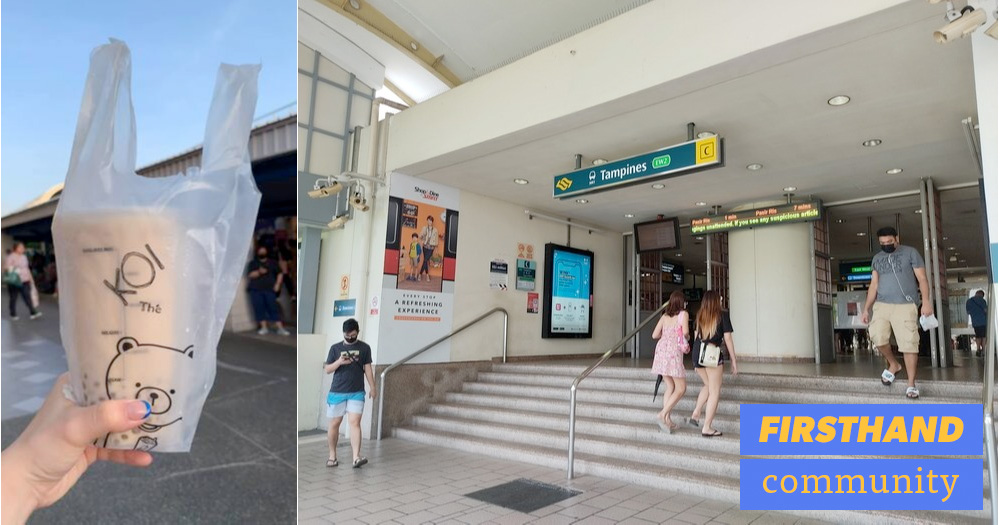Firsthand: Community is a new series by Mothership, where we explore the spirit of community in Singapore through in-depth articles and videos.
From Tampines to Tuas, we’ll investigate the untold stories of the different neighbourhoods in Singapore — firsthand.

Singaporeans love their bubble tea.
Since being introduced to Singapore in 1992, bubble tea has become an essential beverage for many Singaporeans.
But is there a place in Singapore that can be crowned the bubble tea capital?
There's Queensway for sport shoes, Sim Lim Square for PC parts and computer peripherals, Bras Basah Complex for used books.
Could there be a similar location for bubble tea?
Surely, you might think, it would be the glitzy malls of Orchard Road — the place where the flagship outlets of new consumer brands draw long queues.
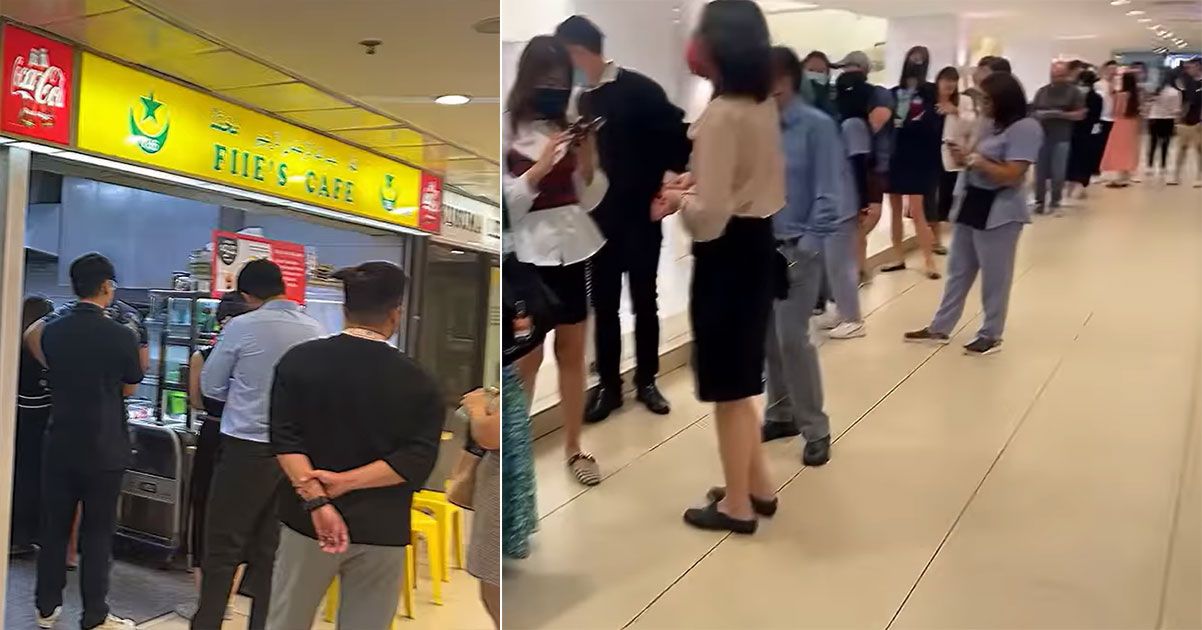 A queue for a popular Nasi Goreng stall on Orchard Road. Photo from MakanFM on Facebook.
A queue for a popular Nasi Goreng stall on Orchard Road. Photo from MakanFM on Facebook.
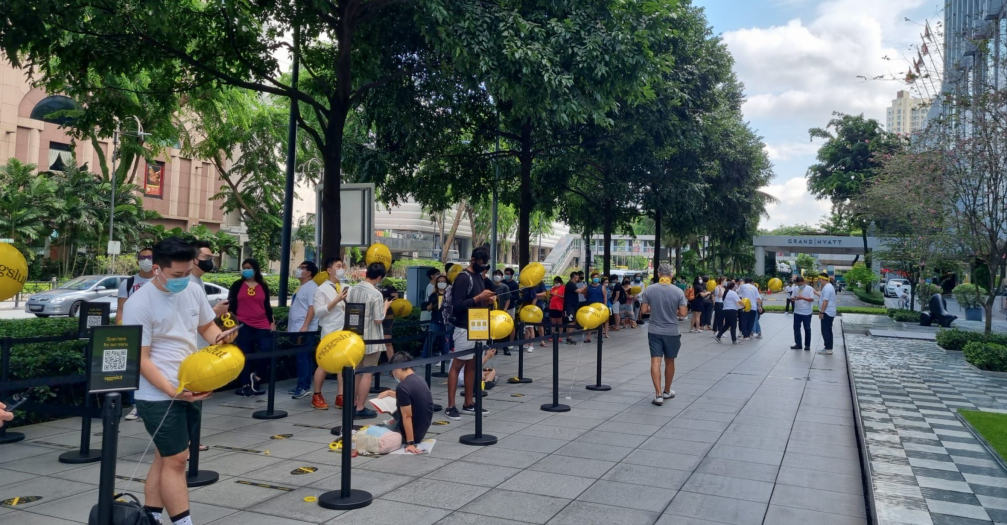 Long queues were seen at the opening of the Eggslut restaurant at Orchard Road. Photo from Eggslut Singapore.
Long queues were seen at the opening of the Eggslut restaurant at Orchard Road. Photo from Eggslut Singapore.
But according to a Facebook post by All Singapore Stuff in 2019, the bubble tea capital of Singapore is a town in the east — Tampines.
Now, being the "bubble tea capital" is a pretty big claim to fame.Do Tampines residents really get to claim this title?
It is time to answer the question once and for all—with the power of facts, numbers, and science.
I embarked on a quest to crunch the numbers and consult the experts.
I even headed down to Tampines to see it for myself.
Step 1: The bubble tea database
Our journey begins with an Excel sheet. I set out to create a comprehensive list of all the bubble tea shops in Singapore.
I started by making a list of bubble tea brands from internet searches and the collective wisdom of colleagues.
Then, I went to each brand's website to find out their shop locations, and listed them in a spreadsheet.
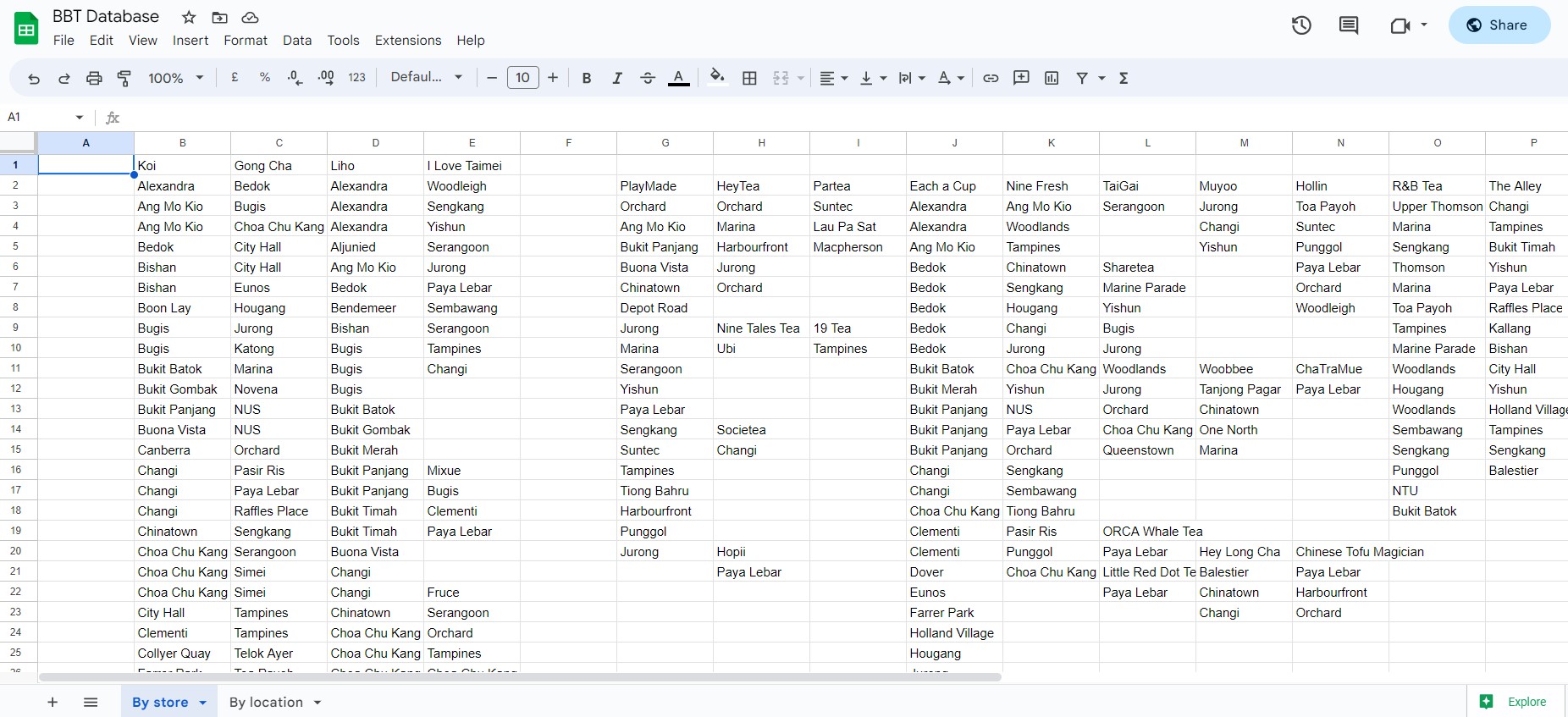 It's messy, but it works.
It's messy, but it works.
It took a while, but I was finally done with a broad sweep of which areas had the greatest number of bubble tea shops.
With this extensive spreadsheet, I could now narrow down the bubble tea hotspots, and rule out places that definitely wouldn't be the bubble tea capital.
The initial list
Six areas stood out: Jurong, Tampines, Orchard, Yishun, Woodlands, and Sengkang.
Now, I was just missing the small bubble tea brands that wouldn't immediately come to mind or have a website I could easily check.
So I hopped onto Google Maps, zoomed in on those six areas, and caught all the tiny shops that I'd missed.
With that, I made an initial list of shops in the most bubble-tea-dense areas in Singapore.
| No. | Jurong (40) | Tampines (36) | Orchard (30) | Yishun (30) | Woodlands (26) | Sengkang (25) |
| 1 | Bober Tea | 19 Tea | Bober Tea | Bb Tea House | Bober Tea | Bober Tea |
| 2 | Chicha San Chen | Bober Tea | Cha Men | Bober Tea | Chicha San Chen | Chicha San Chen |
| 3 | Chicha San Chen | Bubblecute | Chicha San Chen | Bubblekia | Dew Station | Each A Cup |
| 4 | Cold Rock | Bumble Tea | Chicha San Chen | Chicha San Chen | Each A Cup | Each A Cup |
| 5 | Each A Cup | Chicha San Chen | Chicha San Chen | Each A Cup | Each A Cup | Each A Cup |
| 6 | Each A Cup | Each A Cup | Chicha San Chen | Each A Cup | Each A Cup | Gong Cha |
| 7 | Gong Cha | Each A Cup | Chinese Tofu Magician | Each A Cup | Gong Cha | I Love Taimei |
| 8 | HeyTea | Each A Cup | Each A Cup | Each A Cup | Gong Cha | Koi |
| 9 | I Love Taimei | Each A Cup | Each A Cup | Gong Cha | iTea | Koi |
| 10 | iTea | Fat Cat Bubble Tea | Gong Cha | I Love Taimei | iTea | Koi |
| 11 | iTea | Fruce | Hearty Xiang Gang | iTea | iTea | Koi |
| 12 | iTea | Gong Cha | HeyTea | iTea | Koi | LiHO |
| 13 | iTea | Gong Cha | HeyTea | iTea | Koi | LiHO |
| 14 | iTea | I Love Taimei | Hollin | iTea | LiHO | LiHO |
| 15 | iTea | iTea | Hot & Cold | Ice Talk | LiHO | LiHO |
| 16 | Its bubblin | iTea | Ice Talk | Koi | LiHO | Nine Fresh |
| 17 | Koi | iTea | Koi | Koi | Milksha | Nine Fresh |
| 18 | Koi | Koi | Koi | Libertea | Nine Fresh | PlayMade |
| 19 | Koi | Koi | Koi | LiHO | R&B Tea | R&B Tea |
| 20 | Koi | Koi | Koi | LiHO | R&B Tea | R&B Tea |
| 21 | LiHO | LiHO | Koi | LiHO | Sharetea | Taipei Zhan |
| 22 | LiHO | LiHO | Koi | Muyoo | Sweet Heart Shop | TeaGIF |
| 23 | LiHO | Milksha | LiHO | Nine Fresh | Sweet Talk | The Alley |
| 24 | LiHO | Nine Fresh | LiHO | PlayMade | Sweet Talk | The Whale Tea |
| 25 | LiHO | PlayMade | LiHO | Sharetea | Tea Time | Yi Fang |
| 26 | LiHO | R&B Tea | Machi Machi | Sweet Talk | Teavana | |
| 27 | Muyoo | Snowcup | Milksha | The Alley | ||
| 28 | Nine Fresh | Sweet Talk | Nine Fresh | The Alley | ||
| 29 | PlayMade | Tea Tree Cafe | PlayMade | Ulu Tea | ||
| 30 | PlayMade | T.Go Express | Sharetea |
World Tea House
|
||
| 31 | Sharetea | The Alley | ||||
| 32 | Sharetea |
The Alley
|
||||
| 33 | Sweet Talk | Wanpo Tea House | ||||
| 34 | Sweet Talk |
World Tea House
|
||||
| 35 | Sweet Talk |
Yocha Tea & Desserts
|
||||
| 36 | Tea Dough | Yocha Tea & Desserts | ||||
| 37 | Teavana | |||||
| 38 | The Whale Tea | |||||
| 39 |
Wanpo Tea Shop
|
|||||
| 40 | Yi Fang |
Step 2: Refining the criteria
A quick glance at the above table might suggest that Jurong is the bubble tea capital.
Not so fast, though: there's still a small flaw in the methodology that needs to be corrected.
I counted areas like Jurong East, Boon Lay, Lakeside, and Pioneer as part of Jurong. But that might not be fair.
Although most people would consider Pioneer to be part of Jurong (or at least the Jurong region), it is four MRT stations away from Jurong East.
Naturally, the area we know as "Jurong" would have more bubble tea shops than Yishun, but that isn't particularly surprising or meaningful.
Furthermore, if you told me I was in Singapore's bubble tea capital, it'd seem a little unreasonable to have to take a bus or MRT just to get to a particular bubble tea shop.
We are doing serious investigative journalism here. We need a narrower, more scientific definition of the bubble tea capital.
Walking distance
From the background image in the viral post, the claim that Tampines was the bubble tea capital seems to have been premised on the density of options, not just the number.
We should be able to not only know that a place is the bubble tea capital, but be able to feel it as well.
So it's probably fair to say that a bubble tea capital should have a lot of bubble tea shops that are within comfortable walking distance — so much that a tourist who wandered in for the first time might wonder, "Why are there so many bubble tea shops here?"
An average Singaporean can cover 500 metres in slightly less than five minutes, walking at our comfortable world-leading average pace of 6.1km per hour. That sounds pretty reasonable for walking distance.
This worked out with a real-life example. I consulted Google Maps and found the distance between the Mothership office and the nearest bubble tea shop — slightly less than 500m — which most colleagues were willing to walk to buy bubble tea, but no further.
So, our final definition:
The bubble tea capital of Singapore contains the most number of bubble tea shops within a 500m radius of its MRT station.
Step 3: Mapping it all out
I then plotted out every single bubble tea shop in the above six locations: Tampines, Jurong, Orchard, Yishun, Woodlands, and Sengkang.
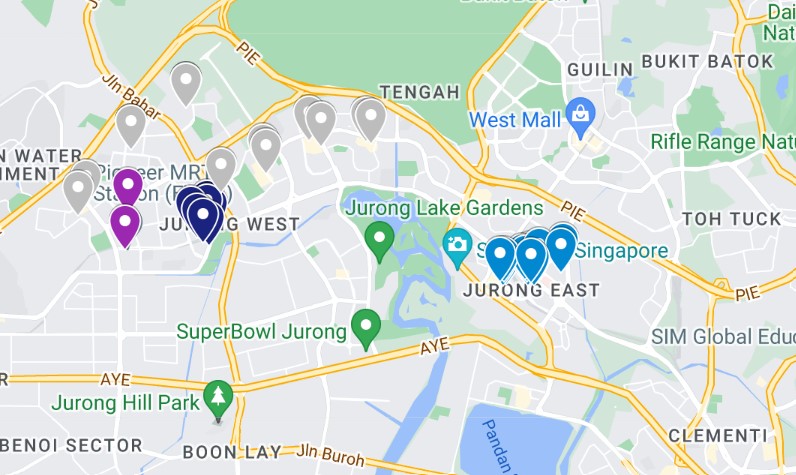 Jurong
Jurong
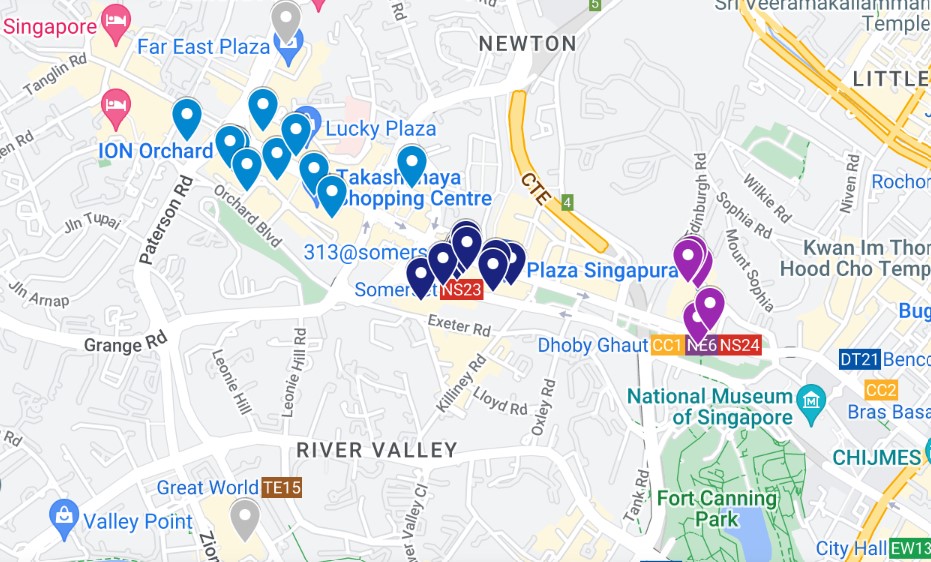 Orchard
Orchard
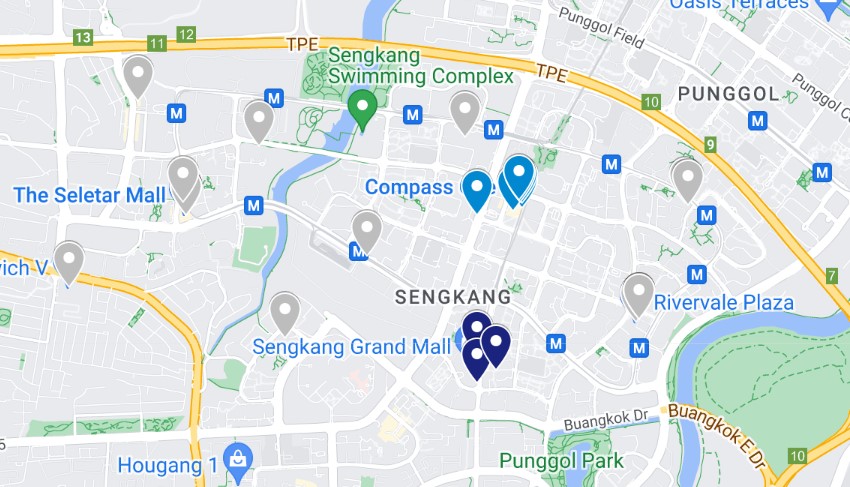 Sengkang
Sengkang
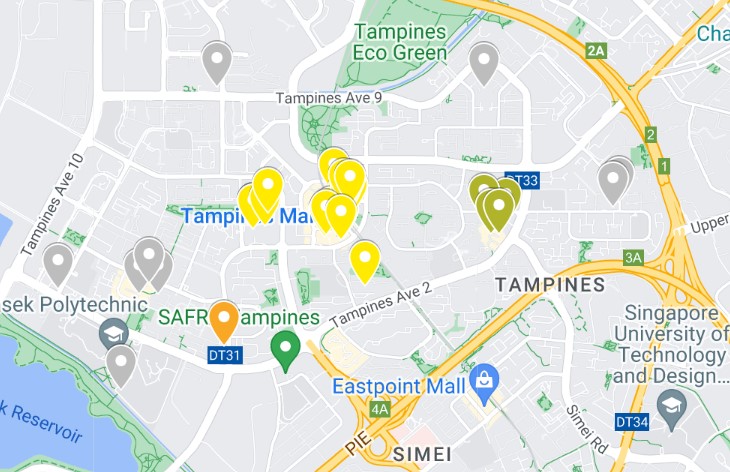 Tampines
Tampines
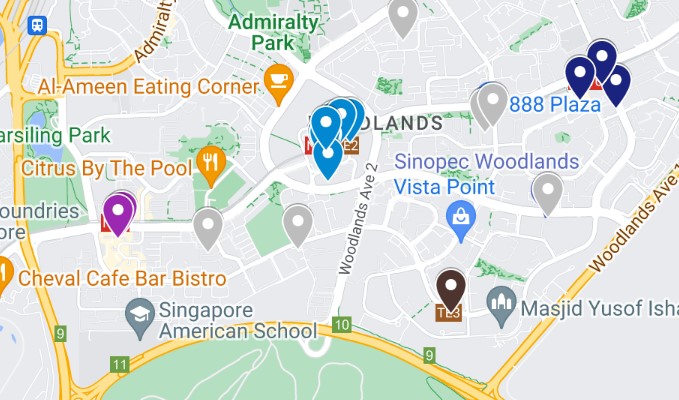 Woodlands
Woodlands
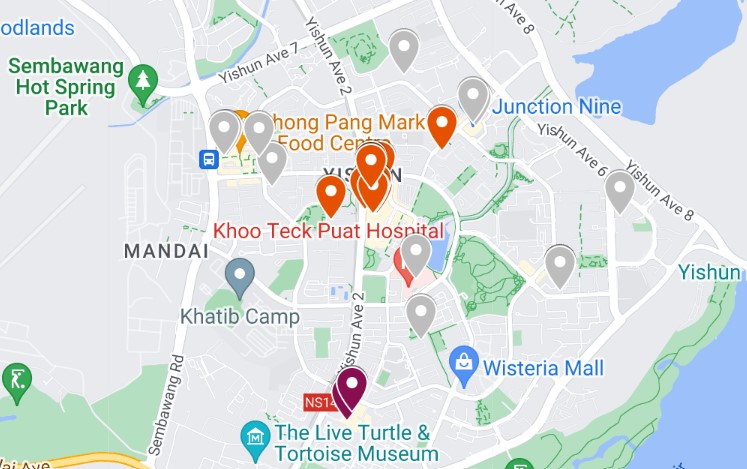 Yishun
Yishun
By plotting the maps out in this way, I could eliminate any bubble tea shop further than 500m away from its area's MRT station (indicated in grey).
Orchard indeed emerged as a strong contender, since many of its shops were, after all, along Orchard Road.
But one would hardly feel the density of bubble tea while walking from Orchard MRT to as far as Dhoby Ghaut (even though it's technically still Orchard Road).
We could also rule out places like Yishun, where a good number of bubble tea shops lay in the homely heartland malls outside Yishun Ring Road — way farther than you'd walk to from Yishun MRT station.
Woodlands and Sengkang were eliminated for similar reasons.
But here's where Paya Lebar emerged as a possible competitor, since it also had a cluster of bubble tea shops very close to the MRT.
So I plotted the bubble tea shops in Paya Lebar, too.
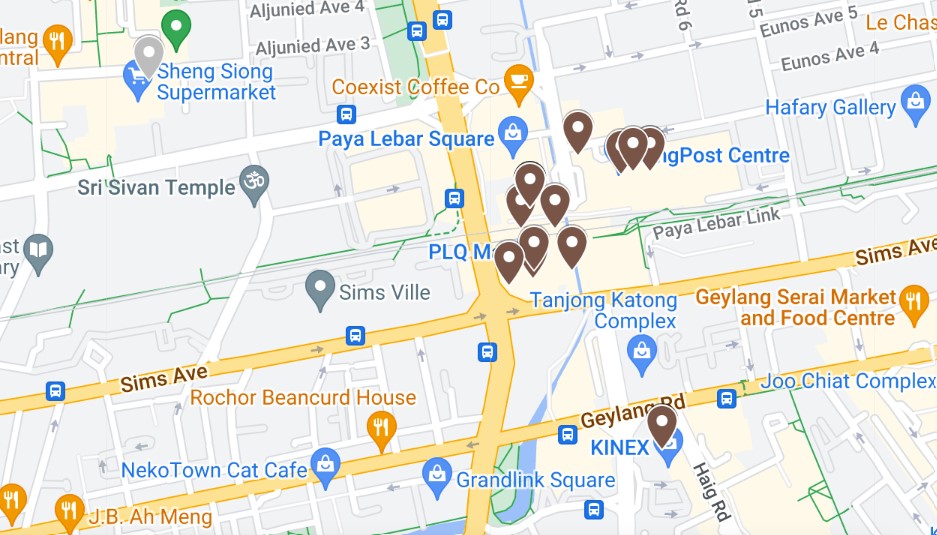 Map of bubble tea shops in Paya Lebar
Map of bubble tea shops in Paya Lebar
Here is a table showing the number of bubble tea shops within a 500m radius of each MRT station.
Number of bubble tea shops with a 500m radius of the MRT:
| MRT Station | Count |
| Tampines | 21 |
| Paya Lebar | 17 |
| Yishun | 17 |
| Jurong East* | 16 |
| Somerset | 13 |
| Orchard | 11 |
| Boon Lay | 10 |
| Woodlands | 8 |
| Sengkang | 6 |
| Dhoby Ghaut | 5 |
| Buangkok | 4 |
| Tampines East | 4 |
| Admiralty | 3 |
| Pioneer | 2 |
| Khatib | 2 |
| Marsiling | 2 |
| Tampines West | 1 |
| Woodlands South | 1 |
*Note: The number for Jurong East includes two shops in JCube, which is closing down in August.
It turns out that Tampines has the most number of bubble tea shops within walking distance of the MRT.
Accounting for variety
As I was making this list, I noticed that some outlets were showing up... a lot.
For example, Tampines MRT has three Koi, two Gong Cha, and two LiHO outlets within a 500m radius.
Some people might think that a true bubble tea capital would not just have a large quantity of bubble tea outlets. Perhaps it needs a large variety, too.
So, here's another list that ranks the MRT stations according to the most number of unique bubble tea shops within a 500m radius.
This means that Koi, for example, will only be counted once under Tampines for this list.
Number of unique bubble tea shops within a 500m radius of the MRT:
| MRT Station | Count |
| Tampines | 17 |
| Paya Lebar | 16 |
| Yishun | 15 |
| Jurong East | 13 |
| Somerset | 13 |
| Boon Lay | 8 |
| Orchard | 8 |
| Woodlands | 7 |
| Sengkang | 6 |
| Dhoby Ghaut | 5 |
| Buangkok | 4 |
| Tampines East | 4 |
| Admiralty | 3 |
| Pioneer | 2 |
| Khatib | 2 |
| Marsiling | 2 |
| Tampines West | 1 |
| Woodlands South | 1 |
The winner for this category is, once again, Tampines.
Step 4: Verifying the results
There's one last test that we need to put Tampines through before it can rightfully claim the throne.
My colleagues and I went down to Tampines MRT itself and spent an hour walking through the entire area, to verify that our numbers were correct.
Sure enough, there were 20 bubble tea shops in the malls immediately surrounding Tampines MRT.
We didn't visit the 21st bubble tea shop, because it was a little further away on Tampines Street 12. But a quick online search showed that it was still in operation, with active pages on various food delivery platforms.
 The bubble tea shop on Tampines Street 12 is still in operation, as it has active GrabFood, FoodPanda, and Deliveroo pages.
The bubble tea shop on Tampines Street 12 is still in operation, as it has active GrabFood, FoodPanda, and Deliveroo pages.
So congratulations, Tampines. You are officially the bubble tea capital of Singapore!
Why got so much bubble tea?
Now you know where the bubble tea capital is.
But we were not satisfied with just knowing where. We also wanted to know why.
What makes Tampines so conducive to being a bubble tea capital? Why are there so many bubble tea shops in such a small area?
We headed down to the streets of Tampines and asked people for their thoughts.
Did people realise there was so much bubble tea in the area? Did they particularly care about Tampines being the bubble tea capital?
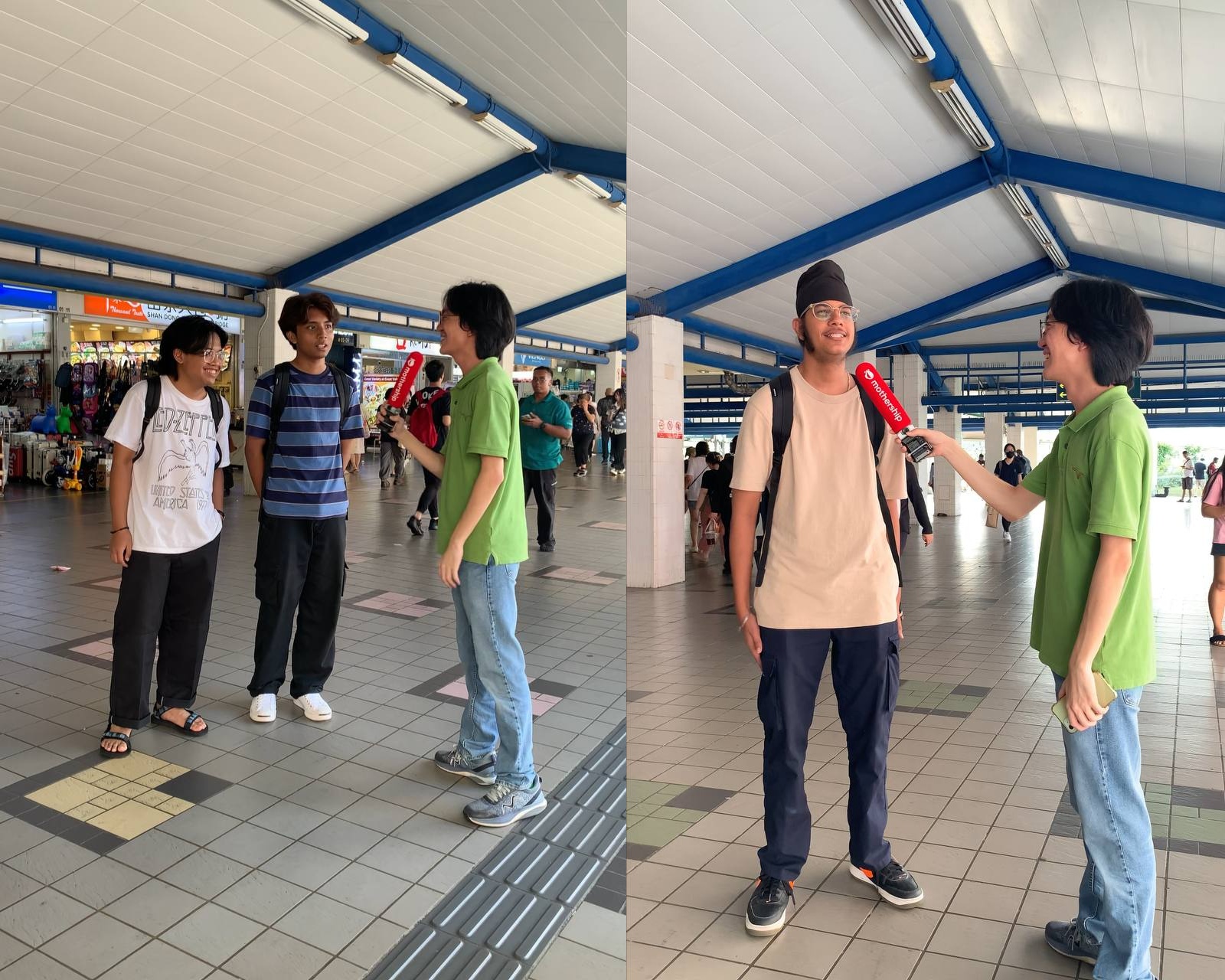 Photos by Kelsy Koh.
Photos by Kelsy Koh.
It turns out that most people were aware of the large density of bubble tea shops in Tampines.
However, many were still surprised to hear the actual numbers. Some even told me they didn't see the need for so many bubble tea shops.
And, of course, some people gleefully claimed that the bubble tea capital being in Tampines was proof that the east is better than the west.
I'll let you pass your own judgment on that.
We asked an expert for her thoughts
I consulted the expert opinion of Sky Kiat Ying Seah, Academic Director for the MSc(Real Estate) programme and Senior Lecturer at the NUS Department of Real Estate.
Seah, whose research interests include spatial analysis and economics, introduced me to the concept of market area:
"The main reason as to why different retail goods have different market areas is that they require different levels of customer base to stay profitable.
Bubble tea outlets require a smaller customer base."
For that reason, each bubble tea shop has a small market area. In other words, a given amount of space (e.g. Tampines) can accommodate a relatively large number of bubble tea outlets.
Bubble tea shops can thus end up being located in close proximity to each other.
By contrast, furniture retail outlets are an example of shops that have a large market area. Accordingly, you will see a smaller number of furniture retail shops distributed over that same space.
But why does everyone set up shop at Tampines?
That's one question answered. But why Tampines, of all places?
As a spokesperson for local bubble tea brand LiHO shared, Tampines is home to many amenities such as sports complexes, schools, and shopping centres.
LiHO currently operates two bubble tea outlets in Tampines, one of which began operations in 2016.
Furthermore, the spokesperson added, they are anticipating future residential developments in areas like Tampines.
As a result, Tampines is a good location for any bubble tea brand to reach a significant customer base.
Seah agreed, saying:
"Bubble tea shops have a wide demographic appeal, with the appeal tending to be stronger among the younger crowd.
As a result, you do see that bubble tea outlets tend to be located near enrichment centers, schools, and tertiary institutions."
Indeed, within the vicinity of Tampines MRT station, there are many schools like Tampines Secondary School, Pasir Ris Secondary School, and St. Hilda's Secondary School.
Students from other schools in Tampines may also pass by Tampines MRT on their commutes.
Meanwhile, Tampines Mall alone houses five enrichment centres, including The Learning Lab and Stalford Learning Centre.
Standing out from the crowd
Still, with so many bubble tea shops within close proximity, how do these brands differentiate themselves from one another?
LiHO's spokesperson said that the brand tries to differentiate from its competitors by providing a Healthier Choice drinks menu, as well as by introducing new bubble tea flavours.
The top two most popular LiHO drinks in the last year are the Earl Grey Milk Tea and the Lychee Rose Jing Syuan. The latter flavour is unique to LiHO, which indicates some success with offering differentiated products.
Seah added that bubble tea brands often offer frequent-visit promotion efforts to enhance brand loyalty.
However, she also said that customer loyalty is difficult to achieve for most bubble tea brands.
Seah explained: "Bubble tea is a good that has close substitutes among the different brands. A brown sugar milk drink tastes relatively the same, and costs relatively the same, from any outlet."
A win for the heartlands
There's your answer. Now we know where the bubble tea capital is, and why.
During my search for the bubble tea capital of Singapore, I was pleasantly surprised to see so many heartland neighbourhoods competing for the top spot.
In fact, Tampines, Jurong, and Woodlands are located at various corners of Singapore — far from central locations like Orchard and Somerset.
Tampines's victory as the bubble tea capital speaks to the success of the plan to decentralise development to regional centres across Singapore.
After all, according to LiHO and Seah's responses, it seems that bubble tea shops choose to set up shop in places with large numbers of people, especially younger audiences.
A larger concentration of bubble tea shops in an area would thus suggest that the area has a large population, including a good number of younger people.
Perhaps this investigation is not just a victory for any one neighbourhood, then. It turns out that our heartlands, located in the geographic fringes of Singapore, contain just as much life as the city centre does — at the very least, for those who'd agree that "bubble tea is life".
Regardless: Tampines residents, you have every right to celebrate. You are officially living in the bubble tea capital of Singapore.
And there's a good reason for it, too.
Have something even more interesting going on in your neighbourhood? One-up us at firsthand@mothership.sg.
Firsthand is a new content pillar by Mothership, featuring in-depth stories about people and their issues.

Top photos by Kelsy Koh and from Wikimedia Commons.
If you like what you read, follow us on Facebook, Instagram, Twitter and Telegram to get the latest updates.

